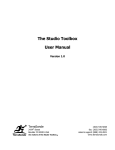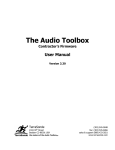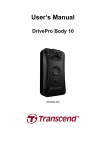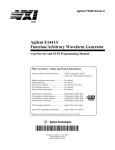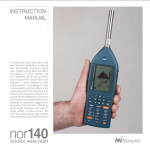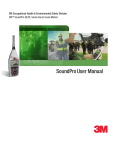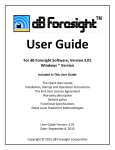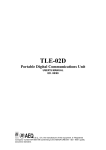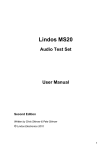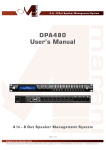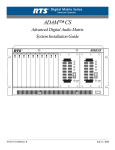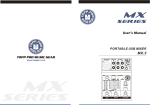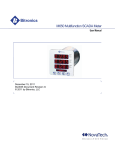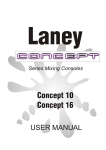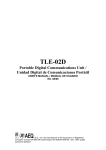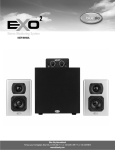Download The Audio Toolbox User Manual
Transcript
The Audio Toolbox User Manual Version 3.05a TerraSonde th 2434 Street Boulder CO 80301 USA the makers of the Audio ToolboxTM (303) 545-5848 fax: (303) 545-6066 sales & support (888) 433-2821 www.terrasonde.com 2 TerraSonde reserves the right to make changes in specifications and other information contained in this publication without prior notice, and the reader should in all cases consult TerraSonde to determine whether any such changes have been made. This manual may not be reproduced, and is intended for the exclusive use of TerraSonde users. The terms and conditions governing the sale and use of the Audio Toolbox consist solely of those set forth in the written contracts between TerraSonde and its customers. No statement contained in this publication, including statements regarding capacity, suitability for use, or performance of products, shall be considered a warranty by TerraSonde for any purpose or give rise to any liability of TerraSonde. In no event will TerraSonde be liable for any incidental, indirect, special, or consequential damages (including lost profits) arising out of or relating to this publication or the information contained in it, even if TerraSonde has been advised, knew, or should have known of the possibility of such damages. The Audio Toolbox described in this document is copyrighted and is confidential information and a proprietary product of TerraSonde. The copyright laws prohibit the copying of this manual or any of the support software programs without the written consent of TerraSonde, except in the normal use of the product, or to make a backup copy. This exception does not allow a copy to be made for others. Copying, under the law, includes translating into another language or format. (c) Copyright 1998-2000 All Rights Reserved TerraSonde 2440 30th Street Boulder, CO 80301 USA (303) 545-5848 FAX (303) 545-6066 www.terrasonde.com All rights reserved. Printed in USA Revised: February, 03 General Notice: some of the product names used herein have been used for identification purposes only and may be trademarks of their respective companies. The Audio Toolbox is a trademark of TerraSonde. 3 Table of Contents OPERATING INSTRUCTIONS ...................................................................... 7 STANDARD AUDIO TOOLBOX CONNECTORS AND CONTROLS ....................................................... 7 QUICK START................................................................................................................ 8 Out of the box: Using the RTA .................................................................................. 8 INPUTS AND OUTPUTS ....................................................................................................11 Overview ...............................................................................................................11 XLR and 1/4” Combo Left Input................................................................................11 XLR and 1/4” Combo Right Input..............................................................................11 RCA phono plug Inputs ...........................................................................................12 XLR Audio Output ...................................................................................................12 1/4” Balanced audio output jack...............................................................................12 RCA phono plug output ...........................................................................................12 1/4” Stereo Headphone Output Jack / Built-in Speaker................................................12 Built-in Microphone .................................................................................................12 MIDI Inputs and Outputs.........................................................................................12 POWER – STANDARD AUDIO TOOLBOX................................................................................12 Power Input Jack....................................................................................................12 Power Switch .........................................................................................................12 Battery Holder........................................................................................................12 Rechargeable Battery Pack ......................................................................................13 OPERATING THE AUDIO TOOLBOX .....................................................................................14 Power on and off & software upgrade mode ..............................................................14 Encoder .................................................................................................................14 Focus ....................................................................................................................14 Menus & Navigation ................................................................................................14 TIPS FOR USING THE AUDIO TOOLBOX ................................................................................15 Using the “Gen” and “Mem” jump fields ....................................................................15 Saving favorite user settings ....................................................................................15 Monitoring the input signal ......................................................................................16 ACOUSTIC ANALYSIS FUNCTIONS............................................................ 17 SOUND LEVEL METER .....................................................................................................17 Description.............................................................................................................17 How to use ............................................................................................................17 REAL TIME ANALYZER (RTA) ...........................................................................................17 Theory ..................................................................................................................17 Description.............................................................................................................17 How to use ............................................................................................................17 Memories...............................................................................................................18 ENERGY-TIME GRAPH .....................................................................................................18 Description.............................................................................................................18 How to use ............................................................................................................18 Memories...............................................................................................................19 REVERB DECAY TIME (RT60)...........................................................................................19 Description.............................................................................................................19 How to use ............................................................................................................19 POLARITY TESTER .........................................................................................................20 Description.............................................................................................................20 4 How to use the Speaker Polarity function: .................................................................20 How to use the Microphone Polarity function: ............................................................21 How to use the Equipment Polarity function: .............................................................21 DISTORTION METER ......................................................................................................21 Description.............................................................................................................21 How to use the Distortion Meter ...............................................................................21 Notes ....................................................................................................................21 TEST FUNCTIONS ..................................................................................... 22 SIGNAL GENERATOR.......................................................................................................22 Description.............................................................................................................22 How to use the Signal Generator ..............................................................................22 Balanced output and level readings...........................................................................23 Output level range ..................................................................................................23 How to use the Impedance Meter.............................................................................23 LEVEL / FREQUENCY METER .............................................................................................23 Description.............................................................................................................23 How to use the Level Meter / Frequency Counter .......................................................23 How to use the VU/PPM meters................................................................................24 SIGNAL / NOISE RATIO ...................................................................................................24 Description.............................................................................................................24 How to use ............................................................................................................24 SWEEPS......................................................................................................................25 How to use the Sine Wave Sweep ............................................................................25 How to use the Amplitude Sweep .............................................................................25 How to use the Impedance Sweep............................................................................26 Memories...............................................................................................................26 How to use the Sweep Cal function...........................................................................27 SAMPLE SCOPE .............................................................................................................27 Description.............................................................................................................27 How to use ............................................................................................................27 Notes ....................................................................................................................28 CABLE TESTER & CONTINUITY TESTER................................................................................28 Description.............................................................................................................28 How to use the Cable Tester ....................................................................................28 How to use the Continuity Tester .............................................................................28 SESSION HELPERS.................................................................................... 30 TUNER .......................................................................................................................30 Description.............................................................................................................30 How to use ............................................................................................................30 TEMPO COMPUTER ........................................................................................................30 Description.............................................................................................................30 How to use the Smart Click Track .............................................................................30 How to use the Leadin-Laggin..................................................................................31 How to use the Drum Replacer.................................................................................31 MIDI HELPER ..............................................................................................................31 Description.............................................................................................................31 How to use the MIDI Monitor ...................................................................................31 How to use the MIDI Text display.............................................................................32 How to use the MIDI Hex display .............................................................................32 5 How to use the MIDI Mapper ...................................................................................32 How to use the MIDI Cable Tester............................................................................32 MIDI TRANSMIT ...........................................................................................................32 Description.............................................................................................................32 How to use ............................................................................................................32 TIME CODE .................................................................................................................33 Description.............................................................................................................33 How to use the Time Code Reader............................................................................33 How to use the Time Code Generator .......................................................................33 How to use the Time Code Re-Generator (Jam Sync)..................................................33 How to use the Time Code Fault detector..................................................................34 How to use the Time Code Frame Rate analyzer ........................................................34 How to use the Time Code Calculator........................................................................34 HUM CANCELLATION ......................................................................................................35 Description.............................................................................................................35 How to use Hum Cancellation...................................................................................35 UTILITIES................................................................................................. 36 MONITOR AMPLIFIER .....................................................................................................36 Description.............................................................................................................36 How to use the Monitor Amplifier .............................................................................36 How to use the Guitar Headphone Amplifier ..............................................................36 POWER TESTS ..............................................................................................................36 Description.............................................................................................................36 How to use the Phantom Power Tester .....................................................................36 How to use the Battery Tester..................................................................................37 TRANSMIT DATA ...........................................................................................................37 Description.............................................................................................................37 How to use ............................................................................................................37 SETUP & CALIBRATION ...................................................................................................37 Description.............................................................................................................37 How to save user defaults .......................................................................................38 How to use the calibration functions .........................................................................38 General Setup ........................................................................................................38 Audio Toolbox Calibration Procedure.........................................................................39 GAMES .......................................................................................................................40 Ping ......................................................................................................................40 Operation ..............................................................................................................40 ABOUT… ....................................................................................................................40 Description.............................................................................................................40 PC/MAC COMPUTER INTERFACE .............................................................. 41 UPGRADING THE AUDIO TOOLBOX .....................................................................................41 Overview ...............................................................................................................41 Procedure ..............................................................................................................41 Details...................................................................................................................41 UPLOADING MEMORIES TO THE PC/MAC ..............................................................................41 ANSI FILTER RESPONSE .................................................................................................42 SPECIFICATIONS...................................................................................... 43 6 ELECTRICAL SPECIFICATIONS............................................................................................43 Input Impedances ..................................................................................................43 Output Impedances ................................................................................................43 Polarities................................................................................................................43 Power....................................................................................................................43 ACOUSTIC ANALYSIS ......................................................................................................43 Sound Pressure Level Meter.....................................................................................43 Real Time Analyzer .................................................................................................43 Reverb Decay Time.................................................................................................43 Energy Time Graph .................................................................................................43 Polarity..................................................................................................................43 TEST FUNCTIONS ..........................................................................................................43 Signal Generator.....................................................................................................43 Level/Frequency Meter ............................................................................................43 Signal-to-Noise Ratio...............................................................................................43 Sweeps..................................................................................................................43 Sample Scope ........................................................................................................44 Distortion Meter......................................................................................................44 SESSION HELPERS .........................................................................................................44 Guitar Tuner ..........................................................................................................44 Tempo Computer....................................................................................................44 MIDI Functions.......................................................................................................44 Time Code Computer ..............................................................................................44 Hum Cancellation....................................................................................................44 UTILITY ......................................................................................................................44 Monitor Amp ..........................................................................................................44 Cable Tester...........................................................................................................44 Power Tests ...........................................................................................................44 WARRANTY AND SUPPORT POLICIES....................................................... 46 14-DAY TRIAL..............................................................................................................46 SOFTWARE UPGRADE POLICY ...........................................................................................46 CALIBRATION POLICY .....................................................................................................46 WARRANTY .................................................................................................................46 INDEX....................................................................................................... 48 Operating Instructions Standard Audio Toolbox Connectors and Controls The Audio Toolbox measures 5 1/2” x 9 1/2” x 2 1/2” (14cm x 24cm x 6cm). It weighs 2 Lb. (1kg). MICROPHONE LEFT XLR & 1/4” BAL INPUT CABLE TESTER IN, SPEAKER GUITAR IN XLR OUTPUT, (MAIN INPUT) BAL MONO CABLE TESTER OUT, PHANTOM TEST RIGHT XLR & 1/4” BAL INPUT _” OUTPUT, BAL MONO RCA INPUTS RCA OUTPUT STEREO, UNBALANCED UNBALANCED MONO HEADPHONE 1/4” STEREO, 32 OHM MIN. POWER INPUT MIDI OUTPUT 2 MIDI OUTPUT 1 POWER SWITCH (AC AND BATTERY) MIDI INPUT NOTE: ALSO USED FOR SERIAL I/O WITH ADAPTE CABLE ENCODER KNOB 8 Quick Start No time for manuals? Read this to jump-start your Toolbox! In the process you will learn the basics of Toolbox operation, and become a better person. Out of the box: Using the RTA Let’s start with a new Audio Toolbox, still in the box. You can be up and running the RTA in 5 minutes. Here’s how: ÿ Unpack it. Open the box, remove the power and battery modules, and lift the cardboard holder out. Don’t rip the plastic, it just unfolds. You can save the packing material and re-use it, if you ever need to. ÿ Turn it on. Plug the AC adapter in the wall, and plug the other end into the Toolbox. Flip the power switch on and watch the running man move across the screen. (By the way, if you ever want to upgrade the software in the Toolbox, just spin the encoder while this guy is moving – you will enter the Download mode. Flip off the power switch to exit this mode.) ÿ Navigate the menus. The main menu will now come up. It has four choices: Acoustic Analysis, Test Functions, Session Helpers, and Utilities. Turn the knob, and the highlight changes. Put the highlight on the Utilities menu, and click the knob like you are pushing a button. The Utilities Functions menu will appear, with a bunch of function choices. Turn the knob again (you can go either way; try it) and put the highlight on “About…”. Click again. You have entered the About… function, which has tech support info and your software version. What it does not have are data fields, since it is just an information function. The ‘<’ character means “go back” or “exit”, so click the encoder (the highlight will be on the ‘<’) and you will return to the Utilities Function menu. Move the highlight to the ‘<’ and click again, and you’re back to the main menu. ÿ Run the RTA. Since you’re a menu expert now, go to Acoustic Analysis, and then run the Real-Time Analyzer. This is a typical Toolbox function, and has a lot more fields than the About… function had. Looking at the top of the screen, you will see the letters “RTA” in a small box. This is just the function name. ÿ Change the sub-menu. Just to the right of the name you will see the word “Full”. This is the sub-menu field. Not all of the Toolbox functions have submenus, but most do. The RTA has two sub-menus: Full, which is 20-20k analysis, and Low, which covers 10Hz to 332Hz. Turn the encoder once to the right (or several times to the left!) and you will highlight the sub-menu field. Click on it and the screen will re-draw the function in “Low” mode. Change back to Full for this demo. ÿ Change a data field. We’re going to skip ahead a few fields. Unless you are in a fairly loud environment, the display will be mostly blank. So turn the encoder unitl the dark block is in the lower left corner. Now click – it will change to an underline. You have just entered “cursor-lock” for the RTA dB range field. While you are in cursor-lock when you turn the knob, the data value changes. Try it. Change the value until you get some visible bars on the screen. (You will probably have to go down in value – hint: turn the knob counter-clockwise). Now click again to release the cursor-lock. ÿ Change another one. Turn the knob and the highlight will again roam around the screen. Stop when you get to the number field just to the right of the submenu (Full). It will have a number in it. This is the band mode for the RTA. Click the knob and this field will change – no need for cursor lock here, there are only OPERATING INSTRUCTIONS 9 4 choices! You will find that data fields and other fields with a lot of values use cursor lock, while on/off fields and others that have just a few don’t use it. It will all make sense soon. Anyway, change this field, just by clicking the knob, and you will see the width of the bars change. You are changing from octaveband to 1/3 octave band analysis. ÿ Try the cursor. Wonder what all those bars mean? Each one represents the SPL level of a range of frequencies. To see the exact level and frequency band, turn the knob until the dark block is in the lower right corner. Now click, and the block changes to an underline. You have just activated cursor-lock for the …cursor…. OK, the terms are confusing. But turn the knob back and forth anyway, and you will see a line move back and forth on the screen. This is the graph cursor. Now notice that the little numbers above the thick line are changing, too. They show you the frequency band the cursor is hovering over, and the level in dB SPL of that band. Neat. Now click the knob to release the cursor lock and… ÿ Turn on the generator. Turn the knob until you get to the field just next to the word “Gen”. Click to change it to on. Now, if you plug the Toolbox output (any output except the headphone out) into an amplifier and a speaker, you will hear a waterfall. Actually, pink noise. Here’s an exception: everywhere else in the Toolbox, like the Sound Level Meter, Scope, whatever, the word Gen is actually a field that you can click to jump directly into the Signal Generator function, to make adjustments. The RTA only has pink noise available, so it won’t do this little trick. ÿ Save a memory. OK, now get some really cool pattern on the screen (whistle? scream?) and move the highlight to the “On” field and click to turn the RTA off. The display will freeze. So, move the highlight to the word “Mem” and click. You jump straight into the Memory Control screen. This feature is available from all of the functions that draw graphs. Move the highlight to the memory number field, and use your data field skills to change that number to 9. Or whatever. The word to the right of the number indicates what is currently stored in that memory number, which may very well be nothing (“unused”). Release the clicklock and move to the Store field, and click. Your graph is now saved forever (well, almost) in the non-volatile memory chip inside the Toolbox. By the way, these memories can be transferred into a PC or Mac, but that’s a different story. Now click Recall and you will jump back to the RTA, with the memory recalled on the graph. ÿ An “extra” field. That’s almost it for the RTA. We’ve covered all of the fields except the input selector (it says MicL, most likely), the graph resolution selector, and the extra field. This is the field on the bottom of the screen, in the center. So, move the highlight to that field. You can click to activate cursor-lock and then turn the knob to select between a display of the unweighted SPL, Aweighted SPL, C-weighted SPL, or Max Hz. This last one just shows the frequency value (Hz) for the band that is currently the loudest. Use this for feedback control, (to identify the offending frequency), to find the loudest frequency in a room analysis using pink noise, or to test how accurately you can whistle 1000Hz. This field follows the band mode that is currently in effect, so to get the most resolution, switch to 1/3 octave mode. ÿ And to wrap up… The input field can be changed to use the low (more sensitive) microphone range, or the hi range. Or, you can pick one of 3 line input ranges. Then there is the field just to the left of the on/off field – this one controls how quickly the RTA reacts – and the graph resolution field, which is OPERATING INSTRUCTIONS 10 the top dB number on the left graph axis. Clicking this alternates between 1.0dB/pixel resolution and 0.5dB/pixel resolution. ÿ Now you’re an expert. Really at this point you know about everything you need to operate the Toolbox. You can navigate menus, change data values, use the cursor, and store and recall memories. As much as possible, all of the Toolbox functions use the same principles of operation, so you should be able to apply what you have learned in the other functions, also. Need to know more? Read on, there’s more! OPERATING INSTRUCTIONS 11 Inputs and Outputs Overview The Audio Toolbox gets its input from either the internal microphone, called Mic in the Toolbox, or the line input jacks, which are called Ext. These inputs each have different ranges that may be used as required. Some functions auto-range, and others require that you select an appropriate range. Depending on need, not all ranges are available in all functions. The internal microphone has two ranges, MicL, and MicH. Minimum Level Microphone Input Range Maximum Level MicL 30 dB SPL 95 dB SPL MicH 65 dB SPL 130 dB SPL The line inputs (XLR and _” combo jacks, or the RCA jacks) feed balanced input amplifiers, with the RCA jacks feeding one side of the balancing network. The 3 ranges available for these inputs are: Line Input Range Minimum Level Maximum Level ExtL -95dBu -35dBu Ext –75dBu +7dBu ExtH –40dBu +40dBu You may use either the XLR and 1/4” combo input jacks, or the RCA input jacks, depending on the type of cable you are working with. Functions that use only one input, like the cable tester, always use the left XLR combo or RCA jack. For output, you may use either the XLR, 1/4” TRS, or RCA jack. All carry the same signal. Any of them may be used for the cable test. The phantom power test uses the XLR output connector. The output range of the Toolbox is –78dBu to +17dBu. The 1/4” stereo headphone jack will power 32 ohm (or greater) headphones, or may be used as a stereo line output from the Toolbox. If nothing is plugged into the headphone jack, and the audio output is turned on, it is routed to the internal speaker. In functions that allow using the headphone/speaker output, you can turn this output on and off and set its level independently from the main mono audio output. XLR and 1/4” Combo Left Input This connector is a balanced audio input connector that accepts either an XLR connector or a 1/4” TRS or mono connector. Pin 2 is “hot” on the XLR input. This input can be thought of as the “main” input. Functions that only use one input or that specify Ext, ExtL or ExtH will use this connector. XLR and 1/4” Combo Right Input This connector is a balanced audio input connector that accepts either an XLR connector or a 1/4” TRS or mono connector. Pin 2 is “hot” on the XLR input. This is the right-channel Ext ExtL, or ExtH input. OPERATING INSTRUCTIONS 12 RCA phono plug Inputs These connectors are unbalanced stereo inputs. They are the unbalanced Ext, ExtL, or ExtH inputs. XLR Audio Output Use this connector when a balanced XLR audio output is needed. It is also used for the phantom power test. Pin 2 is “hot”. 1/4” Balanced audio output jack This connector is wired in parallel with the XLR output jack above. It provides a TRS balanced audio output. RCA phono plug output The mono output is also routed to this jack. This is one side of the balanced output. 1/4” Stereo Headphone Output Jack / Built-in Speaker. This jack is designed for headphone output, as well as a stereo line level output if needed. It is the only stereo output on the Toolbox. The built-in speaker is mounted on the output (right) side of the box. It may be turned on in several functions, where it is referred to as the “Sp/Hd” output. The speaker is also used for the microphone polarity test, and as an audible indicator in the cable tester. Built-in Microphone The built-in microphone is mounted in the front of the unit and is used for the acoustical analysis functions. The cylindrical shape is designed to accept a standard 1/2” (nominal) Sound Pressure Level calibrator, such as the B&K 4231. MIDI Inputs and Outputs There is one MIDI input and two independent MIDI outputs. The MIDI reader normally sends the input signal to both outputs. Some MIDI functions route the incoming MIDI messages to one output or the other. The MIDI Input and Outputs are also used with an adapter cable for serial computer communications. Power – Standard Audio Toolbox Power Input Jack The Audio Toolbox takes 6-8vDC unregulated at a minimum of 500ma. It also may be run on 6 AA cells for portable usage. The input connector is a 2.1mm coaxial power connector, positive on the center pin. Power Switch The power switch is mounted towards the front of the Toolbox, and will turn the Toolbox on or off whether powered by batteries or the AC adapter. Battery Holder The external battery holder plugs into the power input jack, and is attached with 2 thumbscrews. You can order extra battery holders from TerraSonde to always have a fresh charge ready. The battery holder takes 6 AA batteries. These batteries actually create a 9 Volt source, but when plugged into the Toolbox, under load, the output drops to around 8 Volts. Thus, the maximum input voltage is not exceeded. You can check the remaining battery life by going to the Utility Menu function “Power”. Make sure you select Alkaline as the battery type. OPERATING INSTRUCTIONS 13 Rechargeable Battery Pack An optional Rechargeable battery pack is available for the standard Audio Toolbox. It contains a sealed lead-acid (SLA) battery and a charger, mounted in a plastic case that clips to the back of the Toolbox. It connects to the Toolbox via a short lead with a power plug attached. For charging, and running the Toolbox on AC power, plug the AC power module into the battery pack. Charging Anytime that the AC power module is plugged into the battery module, the battery will be charging. You cannot overcharge the battery. In fact, we recommend leaving the AC power module plugged into the battery module whenever possible. When the battery is mounted in the Toolbox, and the Toolbox is turned on, it will charge very slowly, since most of the power from the AC power module is being used to run the Toolbox. You can charge the battery either in the Toolbox, or when it is removed. If you have a spare battery module, you can leave it plugged into the AC power module while you operate the Toolbox on the other battery. Auto-switch The battery module uses a latching relay to switch over from AC to battery power, and to prevent the SLA battery from being completely discharged, which can damage it. The switch-over happens automatically as the AC power module is plugged into the battery module. In some cases, it is possible to latch the relay into a state where the battery, even though charged, will not operate the Toolbox. These conditions include plugging the AC power module into the battery module with no or very low AC power present, and extreme physical shock. To correct this condition, just remove the AC power module plug from the battery module, make sure the AC module is getting good power, and plug it back into the battery module. Battery Life & Charging Times The display backlight consumes a good deal of power, and shortens the battery life. There is an option in the Toolbox setup that controls how long the backlight stays on under battery power (it is always on under AC power). Every time you move or click the encoder, the backlight is switched on. To change the backlight on time, go to the Utility Menu, Setup & Calibration function, General sub-menu. You can change this time from 0 to 999 seconds. Battery Life Backlight On 1.3 hours Backlight Off 3.0 hours Charge Time Toolbox Off (or battery removed) 3.0 hours Toolbox On 7.0 hours Calibration function, General sub-menu. You can change this time from 0 to 999 seconds. Battery Life Backlight On 1.3 hours Backlight Off 3.0 hours OPERATING INSTRUCTIONS 14 Charge Time Toolbox Off (or battery removed) 3.0 hours Toolbox On 7.0 hours Operating The Audio Toolbox Power on and off & software upgrade mode The Toolbox can be powered on and off at any time; there is no shutdown procedure. You will notice when you turn on the unit that the “running man” moves across the screen while a countdown appears on the bottom of the screen. During this time the serial number is visible on the top of the screen. Then, you may briefly notice the words “hyper jumping” and then the main menu appears. What is going on here is that while the “running man” is on the screen the Toolbox is running the monitor program. This program only knows how to load the main Toolbox software, and how to do software upgrades. To enter the software upgrade mode, just turn the encoder to the right for serial upgrades, or to the left for MIDI upgrades. See the web site for full details on software upgrades. The monitor program is stored in protected memory, and cannot be erased or altered, even by a failed or interrupted program update. If for some reason your Toolbox ever freezes at the “hyper jumping” screen, a software update should fix it. Contact TerraSonde tech support if you need more information about this feature. Encoder All user input to the Audio Toolbox is done by using the large knob on the front of the unit. This knob turns, and may also be pressed (clicked). Focus The Audio Toolbox uses the concept of “focus” on the screen. To select or change any item, whether a menu selection or data entry field, it must first be selected by moving the focus to that field. The focus is moved by turning the encoder knob. You can tell where the focus is by the location of the highlighted (white text on dark background) block of text. Once the focus is moved to the field that you wish to modify or select, pushing the encoder knob in will select the item (if it is a menu choice), or change the value of the field. Fields that have only a few values, like on and off, or an input selection, can be changed just by clicking the encoder knob. To increase and decrease values, you can turn it right or left while holding the encoder knob in. All data fields, cursors, and fields with many choices use “cursor-lock”. To change the data in one of these fields, such as the Signal Generator frequency field, click the encoder to “lock” it. The highlight will change to an underline, and when the encoder knob is turned, the field’s value will change. You do not have to hold down the knob to change the value. To move off of the data field, click the encoder once again to release the lock. Turning the knob will now move the focus from field to field. Menus & Navigation When the Audio Toolbox is turned on, the four main menus appear on the screen. Turning the encoder knob changes the focus from one menu to the next. The menu OPERATING INSTRUCTIONS 15 that is presently highlighted can be entered by pressing the encoder knob momentarily (clicking). When a sub-menu appears, there will be several choices listed. Each choice represents a different Audio Toolbox function. To select one, turn the encoder knob to move the focus to that item and push the knob in momentarily. The screen for the selected function will appear. To exit from a function back to the sub-menu, move the focus to the ‘<’ symbol and click the encoder knob. The sub-menu will appear. To return to the main menu from any sub-menu, move the focus to the ‘<’ symbol and click the encoder knob. The main menu will appear. Tips for using The Audio Toolbox Using the “Gen” and “Mem” jump fields Some screens have shortcut fields that let you jump directly from your current function into another function, perform a task, and jump back into the first function without using the menus. Currently there are two fields that work this way, the Gen field and the Mem field. Generator On functions that have a Gen field, when you click on it, you will jump directly to the Signal Generator screen. From there, you can adjust the settings of the internal signal generator, such as the frequency, level, or type of signal, and then when you exit the signal generator, you will jump directly back into the previous function. The Signal Generator remembers the field that you modified most recently, and that field will be selected the next time that you jump into Generator. This makes it easier to run through a set of frequencies, for example, when doing testing. For example, from the Sample Scope function, you can click on Gen and jump to the signal generator screen and set up a 1000Hz square wave signal. Then, click the “<” and you will return to the Sample Scope screen. From here you can turn on the signal generator and use the square wave. Memories On functions that have access to the data memories (the graphing functions), a Mem field will be available. When you click this field, you will jump directly to the Memory Control screen. Here, you can save your screen image to a memory, or a recall a memory. When you recall a memory, or just exit the screen, you will return to the function from which the Memory Control screen was called. For example, from the Sweep Amplitude function, you can run a sweep, click on Mem to jump to the Memory Control screen, store the sweep into a memory, and recall another sweep amplitude memory. You will jump back to the Sweep Amplitude function and the stored graph will be displayed. You can also delete memories from the Memory screen. You can choose delete a single memory, or all memories in the Toolbox. Some functions, such as the Sound Study Graph, can automatically store memories. These functions will only store into erased memory positions. Saving favorite user settings The Audio Toolbox has the ability to store a set of favorite values. Just set up the Toolbox the way you like it, and go to the Setup & Calibration function. Then, click on the sub-menu field until Save Defaults appears and click Save in the middle of the screen. Your settings will be stored in non-volatile memory, and will be restored each time you re-power the Toolbox. OPERATING INSTRUCTIONS 16 The stored settings include all the sub-menu selections, Signal Generator values, time code generator and frame rate values, RTA graph settings, and more. See the section in the manual on Setup & Calibration for more information. Monitoring the input signal In most functions, anytime that the signal generator is turned off, the input signal is routed directly to the Toolbox output. This allows you to monitor the input signal. In the SPL meter, when the generator is off the microphone signal is routed to the output. OPERATING INSTRUCTIONS Acoustic Analysis Functions This section discusses the Acoustical Analysis functions of the Audio Toolbox. These functions all use the internal microphone, but can operate with an external microphone. The external mic must be powered by an external mic preamp, and some amount of gain may be required. Sound Level Meter Description Measures the loudness of the ambient sound level in units of standard SPL dB. This is a true RMS-measurement, using ANSI Type 1 standard display time averages, and ANSI Type 1 standard A, B, and C weighting networks. How to use ÿ Select one of the two available ANSI-standard averaging modes: Slow – 1000ms exponential decay, time-averaged SPL. Fast – 125ms exponential decay, time-averaged SPL. ÿ Select one of four filtering modes: A, B, or C weighted, or flat (un-weighted). ÿ The maximum displayed SPL reading is always held in its own field. Reset the Max SPL level value as required. ÿ Select the Internal or an External microphone. External microphones must be calibrated, see the instructions below. ÿ If the signal generator output is desired, use the On/Off and attenuation fields on the second line of the screen, and the Gen field to jump to the signal generator. All generator output waveforms are available, including Siine wave, square wave, white and pink noise, including band-limited pink noise. When the signal generator is turned off, the microphone signal is present at the output. Real Time Analyzer (RTA) Theory ANSI Class 1 octave band or 1/3 octave band filters are applied to the incoming signal, and the results are shown on a graph. Description Analyzes the audio received at the microphone or left line input by dividing the audio spectrum into octaves or 1/3 octaves, and displaying a bar graph that shows the dB levels of each band of sound. The averaging speed is adjustable, and the display can show a 35 or 17dB window. There are two modes, “Full”, which is a 20-20kHz analysis, and “Low”, which covers the low part of the frequency spectrum, from 10Hz to 332Hz. How to use ÿ Select Full or Low frequency mode. ÿ Select octave or 1/3 octave band filters, as shown by 1 or 3. ÿ Select the averaging mode. The numeric value indicates an exponential decay, with a time-constant equal to the value. For example, if you choose 3s (3 seconds), the screen will decay on a 3-second exponential time constant. The longer the time constant, the smoother the display. 18 ÿ Select the appropriate input. Choose MicL (low range mic input, approx. 30 to 95dB SPL range), MicH (high range mic input, approx. 70db to 130dB SPL), ExtL (low range line input, approx. -80dBu to -30dBu), Ext (normal line input range, approx. -50dBu to +7dBu), or ExtH (high line input range, approx. –10dBu to +40dBu). The mic input levels are calibrated with the SPL meter levels. ÿ Turn on the pink noise generator (Gen on). ÿ Clicking on the dB number on the top of the left graph axis changes the graph resolution from 1dB/pixel to 0.5dB per pixel. ÿ Adjust the dB range as needed so that the display fits on the vertical axis by selecting the lower dB value on the vertical axis. ÿ Select the “extra” field. This is the field in the bottom center of the screen. You can choose to see either the full-band SPL level (dB SPL), the A-weighted SPL (dBA SPL), or the C-weighted SPL (dBC SPL). Note that these levels are not as accurate the SPL levels displayed on the SPL meter, but are available to show the SPL level in the room. ÿ Use the cursor to read out the exact dB level and frequency of any bar on the screen. ÿ To freeze the display, turn the RTA “off”. ÿ If an input overload is detected, the word “Overload” appears on the display. It automatically clears when the overload condition ceases. Note: If you connect the output of the Toolbox back to the input and turn on the signal generator, make sure that you select the Ext input (not ExtL) or you will get an overload condition. This can look like the pink noise is rolling off as the frequency increases. Memories The RTA results can be stored in any of 40 non-volatile memories. To access the memories, click on the “Mem” field. You will jump directly to the Memory Control screen, where you can save the current display into a memory, or recall a previously stored memory. As soon as a memory is restored, the RTA screen is displayed. After recalling a memory, you can change the octave band size, change the graph dB range, and use the cursor to read out individual band data and frequency values. Memories stored in Full or Low mode must be retrieved in the same mode. These memories can be transferred to the PC/Mac using the Transmit Data function. Energy-Time Graph Description Shows the decay pattern for sound reaching the internal microphone or line input over time after a pulse has been generated and played through a speaker. Initial delay time is also shown. The graph is calibrated in units of dB SPL vertically, and units of time horizontally. Optionally, the graph can show units of distance on the horizontal axis. How to use ÿ Plug any Toolbox audio output into an amplifier and speaker. Turn the level down at the amplifier! ÿ Select the MicL, MicH, or Ext input. TEST FUNCTIONS 19 ÿ Select the desired units (time, in milliseconds, or distance, in feet or meters). ÿ Select the graph width. If you have selected units of time, this will be in milliseconds. If you have selected units of distance, this is equivalent to the time the sound takes to travel that distance. ÿ Select the desired weighting. A-weighting will roll off most of the low frequencies. In many cases you will get more reliable results in this mode. ÿ Turn the function “on” and carefully turn up the power amplifier to obtain the highest possible signal reading without overloading the Toolbox or creating excessive distortion in the speaker. Results will be displayed on the screen. The display graph the decay of the pulse as measured at the internal microphone. If the graph never decays the level may be too quiet for the noise in the room, or the graph width may be too small. You can stop the display from re-drawing when you have a good example graph and use the cursor, below the display, to move a vertical bar that shows the exact time (or equivalent distance) of any bar on the screen. Thus, you can measure any peak directly to compute room reflections or to phase speaker arrays. To assist in finding speaker system delay times, the time that the first pulse arrives at the microphone is always computed and displayed on the top right hand part of the screen. Memories The Energy-Time Graph can be stored in any of 40 non-volatile memories. To access the memories, click on the “Mem” field. You will jump directly to the Memory Control screen, where you can save the current display into a memory, or recall a previously stored memory. As soon as a memory is restored, the Energy-Time Graph screen is displayed. After recalling a memory, you can use the cursor to read out individual data values. These memories can be transferred to the PC/Mac using the Transmit Data function. Reverb Decay Time (RT60) Description Computes the reverb decay time for a room referenced to the standard RT60 time. RT60 is defined as the time that it takes sound to decay by 60dB. Ear protection is recommended when using this function. The RT60 time may be computed wideband (20-20kHz) with one of the A, B, or C weighting filters in effect. Note: We recommend that you use one of the weighting filters. Otherwise, low-frequency sound that may not even be audible can raise the noise floor of the room, limiting the useful range of the analysis. Also, often low-frequency rumble from traffic, HVAC, or even people walking in other rooms can cause erratic results. How to use ÿ Select A, B, or C weighting, or Flat (full range) for the analysis. ÿ Plug any Toolbox audio output into an amplifier and speaker. Turn the level down at the amplifier! ÿ Set the “Speaker” field to the approximate distance from the speaker to the Toolbox. You may select units of feet or meters. TEST FUNCTIONS 20 ÿ Set the interval time (Int). This is the time between pulses. You can set this between 2 and 4 seconds. Select 2 seconds for relatively “dead” rooms, or 4 seconds for more “live” rooms. ÿ In “Set Min” mode, allow the Toolbox to read the average background noise level in the room. ÿ Change the mode to “Set Max” and carefully turn up the power amplifier. The Toolbox will generate wide-band pink noise. You want the sound as loud as possible, without actually damaging your system or overloading the Toolbox. The Toolbox will compute and display the available decay range. At least 30dB is recommended for an accurate reading. You can also use the output level control on the Toolbox screen to control the level of the sound in the room. ÿ Change the mode to “Run RT60”. The pink noise generator will be cycled on and off as readings are taken. Several readings will be averaged, and the results will be shown. The “Decay Time” field displays the actual time in milliseconds for the sound field to decay by the Decay range amount. The RT60 time field shows the extrapolated time for the sound to decay in the room, were a full 60dB decay range available. ÿ To stop the analysis, change the mode from “Run RT60” to “Stop”. Polarity Tester Description This function is used to determine the absolute polarity of speakers, microphones, and audio equipment. Note: Since The Audio Toolbox uses XLR pin 2 hot, if your system is wired pin 3 hot you will likely get incorrect results! A simple way around this is to use an unbalanced output, either the RCA output or the 1/4” output with an unbalanced 1/4” plug. How to use the Speaker Polarity function: ÿ Select the Speaker sub-menu. ÿ Plug any Toolbox audio output into an amplifier and speaker. Turn the level down at the amplifier! ÿ Make sure that only one speaker is playing, or that the Audio Toolbox is at least 1 foot (or 0.5 meters) closer to one speaker than the other. Make sure that there is a direct audio path from the speaker driver to the internal microphone. ÿ Carefully turn up the amplifier level until the level meter shows a mid-scale reading. If required, change the Input gain field or adjust the system volume level to get a mid-scale reading. If the level is too high, select MicH. ÿ Observe the + and – confidence meters to see that the Toolbox is getting good information from the speaker. Only one bar should be tall. If both bars are tall, then there may be excessive background noise in the room. ÿ Observe the display for either a plus sign (+ = positive polarity) or a minus sign (- = negative polarity). To check the polarity of individual drivers in a speaker cabinet, turn the level down (or select low input gain) and put the Toolbox microphone right up to each individual speaker element. Note: Many speaker manufacturers wire their tweeters out of phase on purpose, due to the phase shift of the crossover network. This is meant to provide smoother phase response at the crossover point. TEST FUNCTIONS 21 How to use the Microphone Polarity function: ÿ Select Microphone mode. ÿ Plug the microphone to be tested into a microphone pre-amp or recording console. (High-output level dynamic microphones may be plugged directly into the left input). ÿ Plug the microphone pre-amp output or an output from the console into any left audio input on the Toolbox. ÿ Turn the Polarity function on, and adjust the level if needed to obtain a midscale reading on the level meter. ÿ Hold the Audio Toolbox internal speaker near the microphone. (You may need to hold it directly up to the microphone to get a good reading.) ÿ Read the polarity on the screen. How to use the Equipment Polarity function: ÿ Select Equipment mode. ÿ Plug any audio output from the Toolbox into the input of the device to be tested. ÿ Plug the device output into any Toolbox left input. ÿ Turn the function on and adjust the output level and input gain as needed to obtain a mid-scale reading on the level meter. ÿ Read the polarity on the screen. Distortion Meter Description The distortion meter uses notch filters to compare the level of the incoming signal with its harmonics and noise (THD+N). This function generates a sine wave at either 63, 125, 250, 500, 1000, 2000, or 4000Hz, and sums the energy in the harmonics (and residual noise) to compute the THD+N. The range is 0.02% to 50%. For most accurate results, the input signal level must be constrained within a range, so we include a bar-graph level meter. Either the line input or internal microphone input may be selected. Note that as long as the correct frequency is chosen, the signal may come from an external sine oscillator, if desired. The display shows the value numerically, and also has a bargraph using a log-scale from 100% to 0.01% THD. How to use the Distortion Meter ÿ Connect the Toolbox output to the input of the device to be measured. (Or use an external sine wave signal source at the correct frequency). ÿ Select MicL (low level), MicH (high level), or one of the line inputs, Ext, ExtL, or ExtH. ÿ Select the desired test frequency. ÿ Turn on the signal generator and adjust the level for a mid-range reading on the level meter. ÿ Read the distortion in %. Notes This function is especially useful for testing speaker distortion, which typically runs in the 1-5% range. Check all of your drivers, looking for differences between left and right drivers. If one driver is much higher, it is probably defective, damaged, or perhaps may fail soon. TEST FUNCTIONS Test Functions This section describes the Test Functions on the Audio Toolbox. All functions that display level data allow you to select the display units as dBu (equivalent voltage level to dBm, referenced to a 600mw power level), dBV (where 0dBV is referenced to 0.0 Volts RMS), Volts average, Volts RMS or Volts Peak-to-Peak. Several other functions use the features of the signal generator. In many cases (such as the Sample Scope), you can use the Gen field to jump directly to the signal generator; then you can set up the generator, and then just click the ‘<’ field to return to the function. Signal Generator Description A general-purpose full-featured crystal-controlled signal generator that creates test tones and standard noise waveforms. There is also an impedance meter subfunction. Note that you can store your own default values for waveform type, frequency, and level, by using the Save Defaults function in the Setup & Calibration function. How to use the Signal Generator ÿ Plug any Toolbox audio output into the desired destination. ÿ Select the desired mode: sine wave, square wave, white noise, pink noise, impedance, or polarity. The polarity waveform looks like a square wave on top (positive), and a sine wave on the bottom (negative) portion of the test signal. This waveform may be used for phase signal tracing with the Sample Scope function. ÿ Turn the generator “on”. ÿ For sine or square wave, select the desired frequency. Octave mode jumps between ISO octave band center frequencies, 1/3 Oct mode steps between ISO third-octave center band frequencies, and fine mode provides for more exact adjustment. Note that square waves are limited to a maximum frequency of 1600Hz, since the digital generator cannot create a good square wave above that frequency. ÿ Set the output level. Coarse mode changes level by approx. 1.5dB, fine mode changes about 0.05dB. Note that there are two ways that the level is shown. First, a bar meter shows the setting of the coarse level. The second tick mark from the right is approximately 0dBU. In the sine and square waves, a small marker appears beneath the coarse line. This is the “fine” setting. As you move the level up and down, the fine setting changes, until you reach either end of the scale. Then the Toolbox automatically switches into coarse mode, until you change the direction of the level change, when it switches back into fine mode. This setting is shown whether the output is on or off so that you have a way to see the approximate output level with the generator still turned off. Also, the actual level measured at the Toolbox output* is shown numerically on the screen. ÿ If desired, lock the generator output. Locking the output will cause the generator to attempt to hold the exact output level setting, as measured on the output connector, even if the load on the generator changes, or if you change the output frequency, which otherwise can slightly change the output level. 23 ÿ You may select the display units. Other Audio Toolbox functions incorporate the signal generator, as required. Note that the RTA has only wide-band pink noise available, due to memory constraints. Balanced output and level readings *Note: You may choose to display the output as it appears on the balanced connectors (XLR and 1/4”), or the unbalanced RCA connector (which will normally be 6dB lower). The reading displayed for the XLR and 1/4” connectors will still be accurate, even if you unbalance the output (by plugging in a 1/4” unbalanced plug, for example), but the reading for the RCA connector will NOT be accurate if the signal has been unbalanced in this manner. The displayed level resolution changes with output level. In the range of –9.95 to +9.95, the output level is shown in steps of 0.05dB. Outside of this range, the step size is 0.1dB. Output level range The sine wave output range of The Audio Toolbox is from approx. –60dBu to +14dBu. These levels may be selected by adjusting the levels in “coarse” mode. However, you can expand this range somewhat by first going to the maximum (or minimum) level in coarse mode, and then switching to “fine” mode and adjusting the level further. By doing this, you can obtain output levels from –78dBu to +17dBu. The maximum white noise level is +9dBu, and the maximum pink noise level is 0dBu. How to use the Impedance Meter ÿ Make a special adapter cable. This is a 1/4” stereo plug, with only the tip and ring brought out on a wire. Make sure that the ground (connector sleeve) is not connected (floating). The ends of the wires are then fitted with probes, alligator clips, or other suitable connectors. Plug this connector into the 1/4” output jack, next to the male XLR output jack. ÿ Connect a standard balanced female XLR to male XLR cable (microphone cable) between the XLR balanced output on the Toolbox, and left Toolbox input. This cable should be as short as possible for the most accuracy. ÿ Select the Impedance sub-menu. ÿ Select the frequency at which to test the impedance. ÿ Connect the load between the two probes on the adapter cable. ÿ Read the impedance in ohms. Note that you can also measure impedance from the Sweeps function. Also, the Sweep Cal function affects the accuracy of the impedance meter. Level / Frequency Meter Description Two sub-menus are available: A stereo audio level meter, and a DIN-standard stereo VU/PPM bar graph meter. The signal generator may be turned on in any of the level meters. To change the settings, click on Gen to go to the signal generator screen and make the needed changes. How to use the Level Meter / Frequency Counter ÿ Plug one or two sources into any audio input connectors. (Note: do not plug two sources into the same channel or the results will not be accurate). ÿ Select the desired display units: dBu, dBV, Vave, Vrms, or Vp-p. SESSION HELPERS 24 ÿ Allow the Toolbox to auto-range, or select one of the manual ranges. ÿ Access the signal generator via the Gen field, as needed. ÿ Select auto-ranging (“Auto”), or one of the 3 available input gain ranges manually. Read the signal level and frequency. The Audio Toolbox reads frequencies from 16Hz to 40kHz. Note: The frequency counter only works in the upper half of each of the input ranges. Therefore, you may see the frequency field value stop responding as the level is decreased, until the meter auto-ranges. You can work around this, if needed, by selecting one of the manual input ranges. The level resolution changes with input level. In the range of –9.95 to +8.50, the output level is shown in steps of 0.05dB. Outside of this range, the step size shown is 0.1dB. If the meter is in auto-range mode, as the range changes, the display may momentarily say “OVER” or “UNDER” as the Toolbox adjusts to the next range. Also, during an overload condition, like when a line-level input is first plugged in and the auto-range has not yet switched, you may hear the signal bleed through the internal speaker. This is normal. How to use the VU/PPM meters ÿ Select the input range, Ext (-77dBu to +7dBu) or ExtH (-45dBu to +40dBu). ÿ Plug a mono or stereo source into any audio input connectors. (Note: do not plug two sources into the same input channel or results will not be accurate). ÿ Set the 0dB reference level. This level may be adjusted from –30 to +20dBu. The level is shown on the VU meter and to the right of the meter, numerically, relative to the reference level set above. A PPM (Peak Program Meter) indicator is shown as a single bar that bounces above the main bar. The PPM meter uses the same reference level as the VU meter. The absolute maximum peak level is shown on the bottom of the screen, and can be reset by clicking the “Max” field. Signal / Noise Ratio Description This function compares the noise floor of a device to the full-scale signal and computes the signal-to-noise ratio. This is a stereo function, and can run simultaneous two channel analysis. How to use ÿ Connect any Toolbox audio output to the input(s) of the device to be measured. ÿ Connect the device output(s) to the Toolbox input(s) (balanced or unbalanced). ÿ Make sure the Signal/Noise sub-menu is “Signal”. The signal generator is turned on in this mode, and you can adjust the frequency and level of the output. Now adjust the generator output and/or the device input level to obtain a full-scale signal on the device under test. This is the “reference” level that the noise floor will be compared to. ÿ Now switch the Signal/Noise sub-menu to “Noise”. The signal generator is turned off, and the Toolbox switches the input to the most sensitive range SESSION HELPERS 25 (ExtL). The noise floor of the device under test is now measured, and the S/N ratio is computed and displayed. Sometimes it may be difficult to know what to use as the correct “full-scale” level for a device. If the device is an analog tape recorder, you should use 0 dB as shown on the tape machine meters (even if the tape machine is adjusted to record a “hot” 0 (like +9, for example). If the device has output metering, adjust the levels for 0 dB on the meter. If the device has no level meters, then adjust the Toolbox output to +4dBu for balanced equipment, and –10dBV for unbalanced equipment. To measure the S/N ratio for a recording device that may not have a direct output, like an ordinary cassette deck, just record the 0dB signal, and play back in the Signal sub-menu, and then switch to the Noise sub-menu and play back some tape that has been recorded with no input signal present. Sweeps The Audio Toolbox has three sweep functions: Amplitude Sweep (frequency response), Impedance Sweep, and a general purpose programmable Sine Wave Sweep. Also, this function has a calibration routine, Sweep Cal, that calibrates the internal voltage readings which are used by the Impedance Meter and the Cable Tester. The Amplitude and Sine Wave Sweep functions vary the frequency once per millisecond, which results in a sonically smooth sweep. The Impedance Sweep and Sweep Cal functions vary the frequency in 1/3 or 1/12 octave steps. This results in more accurate impedance measurements, since the sweep cal function records the internal voltages in 1/3 octave steps. In either case, the frequency changes in integer Hz values only. The Amplitude Sweep function can operate in 1/3 or 1/12 octave mode. In either mode, the generator frequency sweeps smoothly, and the Amplitude Sweep function averages the results over each of the 1/3 or 1/12 octave bands. The sweep time and start and stop frequencies for all sweep functions can be set by the programmable Sine Sweep function. You can set the starting and ending frequencies to any ISO standard 1/3 octave frequency, and the time from 1 to 99 seconds. How to use the Sine Wave Sweep The Sine Wave Sweep function provides a general-purpose programmable, smooth, sine-wave sweep. It can also be used to define the sweep parameters for the other sweep functions. You can set the beginning and ending frequency values, and the sweep time from 1 to 99 seconds. The level is set by clicking the Gen field and jumping to the Signal Generator screen. To use the Sine Wave Sweep function: ÿ Connect any Toolbox output to the device input. ÿ Select the starting frequency value. ÿ Select the ending frequency value. ÿ Select the sweep time in seconds. ÿ Change the OFF field to RUN. How to use the Amplitude Sweep This function measures the frequency response of a device by measuring the average level of each 1/3 or 1/12 octave band in the selected sweep range while SESSION HELPERS 26 the generator smoothly sweeps the sine wave. Note that you can set the starting and ending frequency values and the sweep time in the Sine Wave Sweep function. ÿ Connect any of the Toolbox outputs to the input of the device being tested. ÿ Select the appropriate input. Choose MicL (low range microphone input, approx. 35 to 95dB SPL range), MicH (high range mic input, approx. 70db to 130dB SPL), ExtL (low range line input, approx. -95dBu to –30dBu), the Ext input (normal line input range, approx. -77dBu to +7dBu), or ExtH (high line input range, approx. –40dBu to +40dBu). ÿ If a line input is selected, connect the output of the device being tested to the LEFT input. ÿ Select either the 1/3 octave mode or 1/12 octave mode. ÿ Start the test by changing OFF to RUN. ÿ Wait for the test to finish. ÿ The results are displayed graphically. If an input overload is detected at any point in the sweep, the word “OVERLOAD” will appear on the display. In this case, select a higher input range or lower the output of the device being tested. If the input level of the entire sweep is too low to obtain meaningful results, the words “LOW INPUT” will appear on the display. Choose a more sensitive (lower) input range or increase the output of the device being tested. You may now select the cursor (below the graph) and move it to read the exact measurement and frequency for each band displayed. The generator output level defaults to the Signal Generator output level. If you wish to change the output level, click Gen to go to the Signal Generator screen, and set the level. The new level will be used in the next Frequency Response sweep. See the section below on using the memories. How to use the Impedance Sweep The Impedance Sweep function will plot the impedance of a load versus frequency. You will need to make up a test cable. This is the same cable used with the Impedance Meter function on the Signal Generator. To make this cable, connect two test probes or clips to the Tip and Ring of a _” stereo plug. The ground is left open. ÿ Plug the impedance tester cable into the _” output jack on the Toolbox. ÿ Plug a standard male to female XLR cable (microphone cable) from the Toolbox XLR output jack to the Toolbox Left combo input jack. Use a short cable, if possible. ÿ Select either 1/3 or 1/12 octave mode. ÿ Start the test by changing OFF to RUN. ÿ Wait for the results to be displayed. You may now select the cursor (below the graph) and move it to read the exact measurement and frequency for each band displayed. The generator level is set to a fixed output level (approximately +6dBu) to optimize the impedance measurement. Note that this function uses the results of the Sweep Cal function to obtain accurate readings. See the description below for more information. Also, see the section below on using the memories. Memories The results of both the Amplitude and Impedance sweeps can be stored in any of the 40 non-volatile memories. To access the memories, click on the “Mem” field. SESSION HELPERS 27 You will jump directly to the Memory Control screen, where you can save the current display into a memory, or recall a previously stored memory. As soon as a memory is restored, the sweep screen is displayed. After recalling a memory, you can use the cursor to read out individual data values. These memories can be transferred to the PC/Mac using the Transmit Data function. How to use the Sweep Cal function The Toolbox uses a table of stored internal voltages, one for each 1/3 octave point, to compute accurate impedance values, and also in the Cables Tester to check for cable loss. The values are stored in the table when this function is run. Since this function appeared first in version 2.30 (released July 25, 2000), all Toolboxes manufactured before this date will show improved impedance meter and cable tester accuracy if this function is run. Once it has been run, the table is stored in non-volatile memory, and does not need to be run again. However, it does not hurt to re-run this function at any time. To run the Sweep cal function: ÿ Connect a high-quality, short cable from the Toolbox XLR out to the Toolbox Left XLR input. ÿ Disconnect all other audio cables from the Toolbox. ÿ Click Run to start the function. Wait for it to complete. You should see a fairly straitght line on the graph when the function is done. ÿ Move to the ‘<’ field and exit the function. The table is now stored in memory. Sample Scope Description Oscilloscope-like function that runs at the maximum system sample rate (48 kHz) and shows the incoming signal on a graph. Useful for identifying repetitive waveforms and obvious clipping, distortion, and overranges. Also useful as a graphical phase meter when used in X-Y mode. There is also a vertical bar graph that displays the level of the incoming signal in dBu. The numeric value appears below the bar. How to use ÿ Connect the signal to any Toolbox audio input(s). ÿ Using the sub-menu field, select the graph x-axis scale in milliseconds, or select X-Y (phase) mode. ÿ Select the input mode. The table below lists the input modes and shows the resultant display on the scope screen and the bar graph level meter. Input Mode Scope Signal Displayed Bar Graph Level Meter L Left Line Input Left input signal, dBu R Right Line Input Right input signal, dBu L&R Both inputs, overlayed, triggered on the left input Sum of left and right signals, dBu L+R Both inputs, summed Sum of left and right signals, dBu L-R Both inputs, difference Left signal minus right signal, dBu Mic Internal microphone MicL in level, dB SPL, unweighted ÿ Select the line input gain range desired: Ext, ExtL, or ExtH. This field does not affect the microphone gain, which is set to MicL range. SESSION HELPERS 28 ÿ Set the vertical scale as desired, in units of Volts/division or mVolts/division, by using the field beneath the left graph axis. There are 6 divisions on the vertical scale. In Mic input mode, the vertical scale units are Pa/division, where 1 Pa = 94 dB SPL. ÿ Turn the Sample Scope on, the incoming signal will be displayed. Notes Compared to any dedicated digital oscilloscope, this is a very low-resolution display. Still, there are many times that useful information can be obtained from this function. To maximize the display readability, the display is only cleared every _ second or so. The full vertical scale reflects the scale of the digital 16-bit input stage. If you see what looks like clipping on the maximum vertical scale as the signal runs into the top of the display, then you are over-driving the inputs. There is an automatic trigger level that is set to 1/256th of the maximum vertical scale digital counts to lock the display to repeating waveforms. In X-Y mode, accurate phase relationships can be seen up to approx. 22kHz. Cable Tester & Continuity Tester Description Use the Cable Tester to verify the wiring and functioning of microphone cables, patch cables, or guitar cables. Both a wiring test and an audio test are performed on the audio cables. You can also use the Toolbox as a continuity tester. If a cable is good, the internal speaker beeps. If it is not good, the speaker buzzes. The speaker may be turned on or off. Note that the speaker beep only checks the results of the digital tests. How to use the Cable Tester ÿ Select the cable type from the sub-menu. Microphone cables are BAL >BAL., while guitar cables are UNBAL>UNBAL. The name on the left of the screen corresponds to the output of the Toolbox, and the name on the right corresponds to the input connector. ÿ Move the focus to the Test Stopped field. Push and turn the encoder to change the field to Test Running. ÿ Turn the speaker tone on or off as desired by clicking the “on” field to the right of the Test Running field. First, a digital wiring test is done. The results are shown graphically on the screen. Next, an analog audio test is performed, running 1kHz and then 20kHz through the cable. The drop in transmission levels are shown for each frequency, relative to the values stored in the Sweep Cal tables (see the Sweeps menu for more information). A good cable will have values of 0.0dB for both frequencies. How to use the Continuity Tester ÿ Make a Continuity test cable adapter. This is just two 1/4” plugs, with only the tip connected in each. The other end of each of the wires may terminate in a test probe, alligator clip, or other suitable connector. ÿ Select the Continuity test mode. ÿ Turn the speaker tone on or off as desired by clicking the “on” field to the right of the Test Running field. ÿ Click the Test Stopped field to change it to Test Running to start the test. SESSION HELPERS 29 ÿ Touch the two test probes together. A momentary beep should be heard, and a line should appear on the screen if continuity is present. Each time the test probes are connected together, a short beep will be heard. SESSION HELPERS Session Helpers This section has functions that are useful during recording sessions. Tuner Description The guitar tuner may be used to tune a bass or normal six-string guitar. Several open tunings may be selected. The guitar may have a capo installed, and the entire scale may be “de-tuned” up or down to tune to out-of-tune instruments. In addition to tuning information, the tuner displays information regarding the harmonic content of the note being played. Five small bar graphs are displayed, representing the fundamental, first, second, third, and fourth harmonics. As frequencies corresponding to these bar graphs are detected, the bar grows longer. This is useful in two ways. First, they are a type of signal strength meter, showing how reliable the tuning data is currently. Second, if you detect that the string is in tune at one harmonic, but not at another, it may mean that the strings are old and stretched, and should be replaced. How to use ÿ Select the instrument mode, Guitar, Bass, Cello, Viola, or Violin. ÿ If a guitar or bass is selected, choose the tuning scale. ÿ If tuning a guitar, select Open or Capo. ÿ Select A=440 or skew the tuning as desired. ÿ Select the internal microphone input or LEFT line input. ÿ Play the guitar and tune it. Tempo Computer Description The Tempo Computer consists of three sub-functions: the Smart Click Track, the Leadin-Laggin tempo analyzer, and the Drum Replacer. How to use the Smart Click Track The Smart Click Track provides you with a very accurate click track (electronic metronome) that uses drum samples. You can set the tempo in 2/10 of a beat per minute (BPM) increments, select a time signature, and assign one of 5 stored samples to each 1/8th note in the measure. To use the Smart Click Track: ÿ Select the Smart Click track sub-menu. ÿ Connect any Toolbox output to an amplifier. ÿ Select a time signature. ÿ Set the beats per minute. ÿ Set the samples. The large bars indicate quarter notes, and the smaller bars indicate eight notes. Move the cursor beneath the bar that you want to assign a sample to, and push and click to select between five available samples: K-kick drum, S-snare drum, H-hi-hat, C-clave, T-tom, or leave it blank for none. You can build up any pattern that you like. ÿ If the small speaker/headphone output is desired, turn on the “Sp/Hd” output, and adjust the gain. 31 ÿ Turn the output on, and adjust the gain. How to use the Leadin-Laggin You can use the Leadin-Laggin to compare 2 or 3 tempos to see which is ahead or behind, or to check the calibration of your drum machine or sequencer. It can also be used as a simple click track. To use: ÿ Select the Leadin-Laggin sub-menu. ÿ Plug the external tempo source(s) into the right or left audio inputs. ÿ Select the reference source, left, right, or the internally generated click. ÿ If desired, set the internal click tempo, level, and turn it on. ÿ Select a sample (see the Smart Click Track) for the internal click. ÿ Read the offset in milliseconds of the non-reference tempos and adjust them to reduce the offset to the minimum possible value. Note: The tempo read must be regular; syncopated patterns are not recognized. How to use the Drum Replacer The Drum Replacer is designed for the purpose of replacing a recorded drum with a sample. It works by transmitting a MIDI note when the recorded drum beat occurs. This MIDI note can be offset by up to +/- 100 ms to adjust the “feel” of the drum track. In addition, if the recorded drum can be fed to the Toolbox earlier than it normally occurs, such as from the sync head of an analog tape machine, you can then add an offset to the MIDI note that is generated, and keep increasing the offset until the drum “locks in”. This technique can be used to account for the delay inherent in many samplers due to processing an incoming MIDI note. To use this function: ÿ Select the Drum Replacer sub-menu ÿ Feed the recorded MIDI note to the Audio Toolbox Left input. ÿ Connect either MIDI out port to the sampler’s MIDI in port. ÿ Set the desired MIDI channel, note, value, and velocity. ÿ Adjust the offset as required. MIDI Helper Description This function allows you to display the MIDI data present on a MIDI cable in several forms, to split MIDI events between the two output ports, and to test MIDI cables. How to use the MIDI Monitor ÿ Select the MIDI Monitor sub-menu. ÿ Select ALL MIDI channels or only one channel. The bar graphs show the MIDI activity by type. If no bar is shown, there is no MIDI data of that type. The bar gets longer as more data is sent. The bars are cleared approximately two times per second. MIDI Click is shown as blinking boxes, if present. MIDI Time Code (MTC) is decoded, if present, with the hours and minutes on the top line, and the seconds and frames on the bottom line. Note: The MIDI Time Code is updated on the screen only twice per second, even if continuous values are coming in. SESSION HELPERS 32 How to use the MIDI Text display ÿ Select the MIDI Text sub-menu. ÿ Select ALL MIDI channels or only one channel. AS MIDI commands come in, they are displayed on the screen, two per screen. New messages overwrite old messages. MIDI clock, if present, is shown as a blinking box for clarity. How to use the MIDI Hex display ÿ Select the MIDI Hex sub-menu. ÿ Select ALL MIDI channels or only one channel. AS MIDI commands come in, they are displayed on the screen as raw hexadecimal data. New messages overwrite old messages MIDI clock, if present, is shown as a blinking box for clarity. How to use the MIDI Mapper ÿ Select the MIDI Mapper sub-menu. ÿ Initially, no ports are selected to output MIDI data from the channels. ÿ Change the “—“ field to “1-“ to output MIDI data for that channel to MIDI port 1 only, “-2” to rout the channel to MIDI port 2 only, or “12” to route the channel to both MIDI ports. ÿ To change the status of all of the ports at once, move the focus to Outputs. Otherwise move the focus to the individual channels that you wish to modify. AS MIDI commands come in, they are routed to the port number specified on the screen. MIDI real-time messages, such as clock, start, stop, and continue are always routed to both ports. How to use the MIDI Cable Tester Note: This test is run at 2x normal MIDI transmit rate to try to identify problems with “marginal” cables. ÿ Select the MIDI Cable Test sub-menu ÿ Plug the MIDI cable that you wish to test into the MIDI input jack and either MIDI output jack. ÿ Select the Test Stopped data field. ÿ Push and turn the encoder to start the test. ÿ The results will be shown on the display. MIDI Transmit Description Use the MIDI Transmit functions to output single MIDI commands of an type to help in testing, setup and de-bugging of MIDI systems. How to use ÿ Select the type of MIDI command you wish to send out from the sub-menu: Note On, Note Off, Controller, Program Change, Pitch bend, Key Pressure, Real Time, Channel Mode, or Machine Control. ÿ Set the data for the command as you wish. In some cases this means selecting a command sub-type. ÿ Move the focus to the “Send” data field and push and turn the encoder to send the command out. SESSION HELPERS 33 Time Code Description Use the Time Code functions to read, generate, re-generate, accurately measure the running frame rate of time code, or test for time code faults. Use the Time Code Calculator to help you compute offsets and to solve other time code problems. Note that you can save the generator starting time and frame rate values by using the Save Defaults sub-menu on the Setup & Calibration function. How to use the Time Code Reader ÿ Select the Read L&R sub-menu ÿ Input Linear Time Code (LTC) to any of the Toolbox audio input connectors. ÿ If you wish to generate MIDI Time Code, change the MTC off data field to MTC on. MIDI Time Code will be generated from the time code received at the Left channel input. The offset between the two time codes being read is computed and displayed at the bottom of the screen. If the two incoming time code signals being read are locked at the sub-frame (1/80th frame) level, an asterisk (*) will appear between the L and the R on the screen. If this indicator is not present or is flashing, sub-frame lock is not present or is jittering. Note: This function decodes the information in the time code stream, and does not analyze the actual rate the time code is running. If the frame rate is shown as 30, it simply means that there are 30 frames in each time code second, and that the code is close enough to the nominal rate to be read. Thus, 29.97 code will be shown as “30” or “30dr”. To check that actual running frame rate, use the Frame Rate function below. How to use the Time Code Generator This function generates time code in any of 6 standard frame rates: 24, 25, 30, 30 drop, 29.97, and 29.97 drop. Note that the starting value may be saved in the user defaults (see the Setup & Calibration function for more information). ÿ Select the L, Gen sub-menu ÿ You may input Linear Time Code (LTC) to any of the LEFT audio input connectors. ÿ You may set the generator starting time and frame rate by moving the focus to the generator time fields and changing the values to the desired start times. ÿ Set the desired time code output level. ÿ If you wish to generate MIDI Time Code, change the MTC off data field to MTC on. MIDI Time Code will be generated from the time code generator output. ÿ To begin generating time code, move the focus to the Off data field and change the value to On. ÿ At any time you can click on the Copy field to copy the current time code value from the reader (left input) to the generator. The offset between the time code being read and the time code being generated is computed and displayed at the bottom of the screen. How to use the Time Code Re-Generator (Jam Sync) This function reads an incoming time code signal and re-shapes the signal to create a new, clean waveform. It will generate good code through drop-outs or faulty frames. An offset can be added to the incoming signal. SESSION HELPERS 34 ÿ Select the Regen sub-menu ÿ You may input Linear Time Code (LTC) to any of the LEFT audio input connectors. ÿ You may set an offset to be added to the incoming time code by moving the focus to the offset time fields and changing the values to the desired offset times. ÿ Set the desired time code output level. ÿ To begin re-generating time code, move the focus to the Off data field and change the value to On. This copies the value in the Left reader to the generator and begins re-generating time code. The time code that is output will have the offset added to it before it is sent out. To re-generate the incoming time code with no offset, leave all of the offsets fields blank. The Regen function locks the internal time code generator to the incoming time code stream. It will slew (speed up or slow down) the time code being output by up to +/-1% to accommodate time code that is running a little fast or slow, and to resync after free-wheeling through a section of drop outs. How to use the Time Code Fault detector The Time Code Fault detector will find any frame that is not read as the next expected frame value. This will include missing (dropped) frames, or damaged frames. The location of the last frame fault is displayed on the bottom of the screen. If there are multiple bad frames, the count will increment. At any time, you can clear the count field by clicking on “Clear”. To use this function: ÿ Connect the time code source to any LEFT Toolbox input connector. ÿ Select the Faults sub-menu ÿ Clear the faults indicator as required. Note that often time code starting up or stopping will trigger the fault detector. This is normal operation for this function. You can clear the faults counter after code starts up to look for later problems. How to use the Time Code Frame Rate analyzer This function accurately measures the actual incoming time code frame rate to 0.001 of a frame. The time code data stream is not de-coded in this function. Use the time code reader to see this information. ÿ Select the Frame Rate sub-menu. ÿ Connect the time code to any of the LEFT inputs. ÿ Read the frame rate on the screen. How to use the Time Code Calculator This function allows you to add or subtract time code values. ÿ Select the Calculator sub-menu ÿ Set the first time code by moving the focus to the time and frame rate fields and changing the values to the desired times. ÿ Change the operator data field to the desired operation, either + for addition or for subtraction. ÿ Set the second time code by moving the focus to the time fields and changing the values to the desired time. ÿ Move the focus to the = field and push and turn the encoder to perform the calculation. SESSION HELPERS 35 Hum Cancellation Description The Hum Cancellation function is used to remove hum while recording or performing. Note that this function will not work with recorded material, since it needs to have the line frequency available to lock to. Also, it will not work under battery power for the same reason. How to use Hum Cancellation ÿ Connect the output of the source containing the hum to any of the Audio Toolbox left audio inputs. ÿ Connect any of the Audio Toolbox audio outputs to the console or other line input. (If used with a mixing console, the Audio Toolbox could be patched into the insert points of the channel.) ÿ Adjust the offending device’s output to desired level. ÿ With the hum audible, but the instrument not playing, push and turn the Sample data field to store a sample of the hum. ÿ Move the focus to the Off data field and change this value to On. ÿ Move the focus to the Offset data field and change the offset to minimize the hum. This is usually only a few clicks in either direction. ÿ You are now ready to play the instrument with the hum removed. The hum cancellation is optimized for the output level of the device when the sample is taken. If you need to adjust the output level of the device emitting the hum, just re-sample the hum and re-adjust the offset. SESSION HELPERS Utilities This section contains the descriptions for the Utility functions. Monitor Amplifier Description Use the Monitor Amplifier to trace signals or to listen to the output of a tape machine or CD player. Also, in Guitar mode, you can use the Toolbox as a guitar headphone practice amp. How to use the Monitor Amplifier ÿ Select Line or Mic input. ÿ If Line input is selected, select mono if you wish to route the left input to both output channels. The microphone input appears in mono at the output. ÿ If Line input is selected, plug the audio input source into any of the audio input connectors. ÿ Select the desired line input gain range: 0dB, +40dB amplifier, or 40dB pad. Be careful when selecting the 40dB gain amp, this is often enough gain to drive the output or headphones to full level. ÿ Select the desired input and output gain settings for proper level and to avoid distortion. ÿ If desired, turn on the headphone/speaker output. How to use the Guitar Headphone Amplifier This function lets you listen to a guitar in headphones, complete with effects. You can also plug a source (CD player, drum machine, console output, etc) in and have music to play along with. Note that the main Toolbox output is disabled in this mode, because the output of this function requires both channels for stereo. ÿ Plug an electric guitar into the left 1/4” Toolbox input. ÿ Optionally, plug a sound source into the right Toolbox input. ÿ Plug headphones into the Toolbox 1/4” headphone output. You can also use this output as a line out, if required. ÿ Change the sub-menu to Guitar. ÿ Turn on the headphones by setting the Sp/Hd field to On. ÿ Adjust the levels of the left input (guitar) and the right input (music, if used) fro maximum signal without clipping or distortion. ÿ Adjust the effects as desired. ÿ Adjust the headphone level as desired by changing the Gain field on the Sp/Hd line. Power Tests Description These functions analyze phantom power and display the Audio Toolbox internal battery voltage and remaining battery life. How to use the Phantom Power Tester ÿ Select Phantom mode 37 ÿ Connect a microphone cable to the XLR output connector. The phantom power voltage for each pin is shown on the screen. Note: There is approx. one volt of DC offset on this connector at all time. Do not connect this to a microphone preamp or other device that cannot tolerate this voltage. Also, just after a phantom power test there will be up to 48VDC on this connector, stored in the internal coupling capacitors. Be careful when you plug the Toolbox outputs into a device just after doing a phantom power test. How to use the Battery Tester ÿ Select Battery mode. ÿ Select the battery chemistry: alkaline, lithium, or NiMH, when using the respective AA cells, or select lead-acid when using the TerraSonde rechargeable lead-acid battery accessory. The actual battery voltage and estimated remaining life is shown on the screen. Note: When operating on AC power, such as the AC adapter, or the Rack Mount running on AC power, this field will show the voltage level of the power supply. Transmit Data Description This function enables the PC/Mac serial link, for transferring data memories and printing screens. How to use ÿ Select the function. ÿ Connect the Toolbox to the PC/Mac using the TerraSonde Computer interface cable. This will connect the computer’s serial port to the MIDI In and Out ports on the Toolbox. ÿ Start the PC/Mac program, and follow its instructions. The Toolbox will dump memory data to the host computer as requested. ÿ See the PC/Mac Computer Interface section on page 41 for more details. Setup & Calibration Description Every Audio Toolbox is fully calibrated before it leaves the factory. All calibration constants are stored in non-volatile memory. The calibration functions on the Setup menu of the Audio Toolbox may be used to check or re-calibrate any feature of the Toolbox at any time. The accuracy of your results will be limited by the accuracy of your equipment and methods, so use the best equipment available and follow these instructions closely. The operation of the Audio Toolbox depends on the calibration. If you feel that your Toolbox needs to be re-calibrated, but are not comfortable with doing this procedure yourself, TerraSonde will re-calibrate your Audio Toolbox to factory standards at any time for no charge. Check with TerraSonde or your local distributor for details. In addition to the calibration functions, you may also store a set of user default values. See the description of this feature below. Like the other calibration values, UTILITIES 38 these settings are stored in non-volatile memory and are retrieved whenever the Toolbox is turned on. How to save user defaults The user default values include all of the sub-menus last accessed, the last waveform type, frequency, and level values stored in the signal generator, the time code generator values (time and frame rate) last used, tuner reference frequency, tempo last used, RTA graph settings, sample scope settings, and various level settings and input selections in many of the functions. There is only one set of user settings, and each time you re-store the values, all stored settings are updated. To store a set of user defaults: ÿ Go to the Setup & Calibration functions, on the Utilities menu. ÿ If it is not already showing, change the sub-menu until you reach “Save Defaults”. ÿ Move the cursor to the “Save” field and click. ÿ Click on the ‘<’ field to exit the function. All settings are now stored, and will be recalled whenever the Toolbox is turned on. How to use the calibration functions General instructions are provided, as each calibration function operates similarly. ÿ Select the desired calibration function. ÿ Connect the calibration signal or test equipment to the Audio Toolbox. ÿ Set the Cal field to the calibration value. For example, if you are calibrating the input to a known -3.0dBU signal, set the Cal field to –3.0dBU. The value being currently being read will be shown on the “In” line. The difference between the “In” line and the “Cal” line shows the current calibration error for that function. ÿ Move the focus to the Set field for the channel that you are calibrating and click the encoder to calibrate. The “In” field value should now match the “Cal” field. When you click on the “<” to return to the menus, the new calibration constants are stored in non-volatile memory. General Setup This menu has data fields for some miscellaneous values that are stored in the Toolbox. Each is described below. Since you can alter the contents of the calibration values stored in the Toolbox, be careful with these data fields! If you are unsure of what to do, contact TerraSonde technical support before altering these. DC Backlight On This field controls how many seconds the display backlight stays on after moving or clicking the encoder knob, under battery power. Enter any number of seconds from 0 to 999. Keeping the backlight off conserves battery power. The backlight stays on under AC power. Burn-in This field indicates whether or not the Toolbox has been through the burn-in process. When an Audio Toolbox is first powered up in manufacture, it enters a burn-in and self-calibrate state. Several constants are stored at this time. The unit may be forced through the burn-in process again by setting the burn-in data field on the General Setup menu to No, exiting the menu, and powering the unit off and back UTILITIES 39 on. The burn-in procedure takes one hour to complete. Note that this may affect the main calibration. Factory Calibration This field indicates whether or not the Toolbox has been through the factory calibration process. If a unit needs to be re-factory calibrated, this field may be set to “No”. Note that the factory calibration process requires a special TerraSonde calibration fixture. Contact TerraSonde technical support before changing this field. Restore Factory Calibration Every unit is fully tested and calibrated at the factory when it is produced. The calibration constants are stored in non-volatile memory. A second copy of the constants is also stored so that if the first set has been altered, for example by a bad re-calibration procedure, you can always restore the original factory calibration. To do this, set the Restore Cal data field on the General Setup menu to Yes and exit the menu. The original factory calibration will be restored. Audio Toolbox Calibration Procedure Follow these steps to fully calibrate the Audio Toolbox: ÿ Calibrate the output. Connect an output meter to either balanced output. Make sure the meter is wired to read a balanced signal. Now go to the Output Calibration function on the Setup menu. Adjust the output level by using the coarse and fine adjust to read a value such as 0.00dBu on the external meter (the value shown on the Toolbox may not match this number). Then Adjust the CAL data field to match the meter reading and click SET. Now both data fields should match. ÿ Calibrate the inputs. Connect a signal generator to the inputs. You may use either the balanced or unbalanced inputs. Select a mid-band frequency, for example, 1000 Hz. Set a level near 0.00dBu. Set the CAL data field to the level that you are generating, and click the SET data field. Do this for both channels. ÿ Calibrate the Frequency Counter. Using the same hookup as above, now set the signal generator to a frequency as close to 30,000Hz as possible. 20,000Hz will work with slightly less accuracy. Now adjust the CAL field to match the frequency being generated and click the SET field. Note that you can change the value in the “*” field to change numbers faster or slower. ÿ Calibrate the Battery Voltage. Temporarily power the Toolbox from a regulated DC power supply set to 7.00 to 7.50V, and connect a DVM across the inputs. Select the Battery Voltage calibration function and set the CAL field to match the voltage being output. Now click the SET field. ÿ Calibrate the Phantom Power Voltage. Connect a DC power supply set to 45.0 to 48.0 V to the XLR OUTPUT connector on the Toolbox. The negative lead is connected to Pin 1, and the positive to both pins 2 and 3. Set the CAL data field to match the voltage being supplied and click the SET data field. ÿ Calibrate the SPL Meter. Connect an SPL calibrator to the Toolbox microphone mount, or, if none is available, use a high quality SPL meter and the pink noise output from the Toolbox. Either way, generate a known SPL field, as near to 94dBA SPL as possible. Set the SPL LOW CAL field to match the SPL sound field level being generated and click the SET data field. Do the same for the SPL HIGH CAL data field. These steps will calibrate a Toolbox, but note that the factory constants will not be altered by these calibrations. The only way to change the factory constants (which UTILITIES 40 are a backup set of constants that you can always return to) is by using a TerraSonde factory calibrator. Games Ping For those times when there is nothing left to fix, keep your mind occupied with a remake of a classic arcade game. Operation Just change “Stop” to “Start” and your off and running. Move the paddle up and down by turning the encoder. Hit the ball before it hits the wall. But watch out, the ball speeds up every time you hit it. Keep track of your high score. if you need to exit the game before it is over, just hold the encoder down and turn until the “<” is selected and release the encoder. You will return to the menus. About… Description Shows the installed software version number, tech support phone numbers, and tech support web page addresses. UTILITIES PC/Mac Computer Interface Upgrading the Audio Toolbox Overview The Audio Toolbox may be field-upgraded to new software using the MIDI ports on the Toolbox. When connected to a serial port, the MIDI ports are reconfigured internally for serial communications. Minimum requirements for upgrading a Toolbox are: q A PC running Windows 95 or Windows 98, or a Mac q MIDI in and out ports or a serial port on the PC, or a serial port on the Mac (USB is not supported directly – a USB-to-serial adapter is required). q q 2 MIDI cables, or a special Toolbox serial adapter cable (contact TerraSonde or check our web site for details). The Audio Toolbox Upgrader software (a PC or Mac program). q The new Audio Toolbox software (to be downloaded into the Toolbox). q A unique software unlock code. The Upgrader software is available as a free download from the TerraSonde web site. The current Audio Toolbox software is also available for downloading. To get your unique unlock code, call or email TerraSonde. You will need to have your Audio Toolbox serial number and the version of the software that you wish to install, and TerraSonde will give you your unlock code. If you have not registered your Toolbox, you will be required to do so at this time. Note that you may be required to provide proof of purchase to obtain a free software upgrade. Procedure Go to the TerraSonde web site, www.terrasonde.com, then go to the Downloads page, and follow the instructions there. You will have to download the TerraSonde Upgrader program, and the software for the upgrade. Details The program in the Toolbox that communicates with the PC (called the Monitor) is stored in protected, non-volatile memory in the Toolbox. Barring physical damage or abuse, it cannot be erased. This means that even if a faulty program is somehow loaded into the Audio Toolbox, the Monitor program will be safe, and a new, corrected program can still be downloaded to make a functional unit. In fact, several different programs can be stored on the PC hard disk, and loaded in whenever desired. It may possible to get completely different programs for the Audio Toolbox, for special purposes. The unlock code works with a specific Toolbox and upgrade, so be sure to keep the unlock code safe. TerraSonde can always replace the code, if lost. Uploading memories to the PC/Mac From our web site, you can obtain PC/Mac software to extract the data memories from the Toolbox. Check the Downloads page for current software availability. ANSI Filter Response This chart shows the response curves for the ANSI A, B, and C weighting filters. Note that the Aweighting curve actually continues down below the graph. To some people, the A curve represents a typical “speech” frequency distribution, while the C curve represents a typical “music” frequency distribution. Specifications TerraSonde reserves the right to change specifications Electrical Specifications Input Impedances XLR and _” balanced inputs RCA unbalanced 40k ohms 20k ohms Output Impedances XLR and _” balanced outputs RCA unbalanced 300 ohms 150 ohms Polarities Pin 2 is “hot” (positive polarity) on all XLR connectors. The _” connectors all have the tip hot. Power AC power adapter output Batteries 6v-9vDC @400ma 6 AA cells provide 5-8hours of service, depending on usage. Acoustic Analysis Sound Pressure Level Meter +/- 0.3 dB steady state, resolution to 0.1 dB. 35 –130 dBA with internal mic, 25-135dbA with reference mic. RMS detection with ANSI type 1 weighting networks and decay/peak hold time constants. Real Time Analyzer +/- 1.5 dB with internal mic, +/- .5dB with reference mic. Frequency discrimination to +/-1%. Reverb Decay Time +/- 2% of full signal, 10ms resolution. RT60 time is extrapolated from available room dynamic range. Energy Time Graph +/- one graph pixel. Polarity 0 to 500 feet, speaker to Audio Toolbox. Shows polarity of closest driver’s mid-frequency wavefront. Test Functions Signal Generator Distortion <0.1%, sine wave output 20-20kHz, level –35dBu to +17dBu. Impedance meter, range 1 ohm to 8000 ohms, +/- 2% or 0.2ohms, 1 ohm to 50 ohms, 50Hz12.5kHz. Overall, +/-10%. Level/Frequency Meter +/- 0.5dB, 20-20Khz, +40dbu to –85dbu. +/- 1Hz freq. counter. Signal-to-Noise Ratio > 85dB range checking. –80dBu minimum level. Sweeps Frequency Response Sweep +/- 0.5dB or pixel of graph, 20Hz to 20Khz. Impedance Sweep Same specs as Impedance Meter. 20Hz to 20kHz sweep. 1/3 and 1/12 octave band modes. Signal Generator Sweep Same specs as signal generator. 20Hz to 20kHz sweep bandwidth, 10 to 99 seconds duration. 44 Sample Scope Runs at full sample rate, 48kHz. +/- one pixel of display. 20-22kHz.. Distortion Meter 0.02% minimum reading, accurate to +/-5% Session Helpers Guitar Tuner +/- 2 cents. Tempo Computer All functions, +/- 0.2 BPM. Time to <1ms. MIDI Functions One input, two outputs, standard 5-pin DIN MIDI sockets. Time Code Computer +/- 1 frame, all functions. Supports 24 fps (film), 25 fps (EBU), 30 fps (SMPTE) and 30 fps drop (SMPTE drop). 29.97 read as 30. Sub-frame lock indicator +/- 1 sub-frame. Frame per second reader +/- .001 fps. Hum Cancellation 45 dB reduction in line-frequency related hum components. Utility Monitor Amp Up to 40dB of gain. Minimum load impedance 32 ohms. Cable Tester Tests XLR, _:” balanced and single-ended, all XLR to _” combinations. RCA cables also tested. Power Tests Phantom checker shows voltage +/- 0.2V on + and - XLR pins. Battery tester accurate to +/- .02VDC. SPECIFICATIONS Warranty and Support Policies This section contains the complete TerraSonde Audio Toolbox warranty, customer support, and return policies. 14-Day Trial You may return the Audio Toolbox to the place of purchase and receive a full refund within 14 days of purchase. The returned unit must be in as-new condition and must include all original packaging and accessories. If the unit is not in as-new condition, you will be referred to TerraSonde, the manufacturer, to resolve the problem. TerraSonde backs up this promise, so please contact us if any problem occurs. Note: Non-recoverable charges, including shipping charges, credit card transaction fees, and other such costs are exempt from this policy and will not be refunded. Check with your dealer for details. Software Upgrade Policy TerraSonde provides 90-day free software upgrade period. In some cases, you may have to return the unit to the factory for the upgrade. In this case, you will pay shipping to TerraSonde and we will ship the unit back to you after the upgrade at our expense in the USA. International customers must pay shipping both ways. This software upgrade policy does not apply to new features added to the system, only to improvements and corrections made to your existing software. This upgrade policy applies to the basic “Audio Toolbox” software. If major new features or functions are added to the Audio Toolbox, they may be available at extra cost from time to time. Calibration Policy If, at any time, you feel that your Audio Toolbox is not correctly calibrated, and you do not wish to or are not able to calibrate it yourself, you may return the unit to TerraSonde and we will calibrate the unit free of charge, back to original factory specifications. You must pay shipping charges to TerraSonde and we will ship the unit back at our expense in the USA. International customers must pay shipping both ways. Warranty TerraSonde (Manufacturer) warrants the Products, so far as the same are of its own manufacture, against defects in material and workmanship under the normal use and service for which they were designed, for a period of one (1) year after date of shipment. Manufacturer's obligation under this warranty being limited, at its option, however, to the replacement or repair of a part or parts determined by it to be defective. All necessary packing and transportation costs for return of the goods to be paid by sender. The Products must be returned in appropriate packaging, comparable to that used in the original package by Manufacturer. All replacement or required goods will be returned to sender by like means at Manufacturer's expense. Manufacturer shall under no circumstances be liable for any special, indirect or 47 consequential damages owing to failure of the Products. MANUFACTURER MAKES NO WARRANTY OF FITNESS OR MERCHANTABILITY AND NO OTHER WARRANTY, ORAL OR WRITTEN, EXPRESS OR IMPLIED, EXCEPT AS SPECIFICALLY SET FORTH HEREIN. WARRANTY Index A About…, 40 H Hum Cancellation, 35 B Battery AA holder, 12 rechargeable, 13 testing voltage, 37 C Cable Tester & Continuity Tester, 28 Calibration battery voltage test, 39 frequency counter, 39 functions, 38 input, 39 output, 39 phantom power, 39 procedure, 39 restoring factory calibration, 39 SPL, 39 support policy, 46 Click Track, 30 Continuity Tester, 28 D Distortion Meter, 21 E I Impedance adapter cable, 23 input, specification, 43 meter, 23 meter, specifications, 43 output, specification, 43 Sweep function, 26 Inputs 1/4", 11 range, 11 RCA, 12 XLR, 11 L Level / Frequency Meter, 23 M Memories ME jump field, 15 transmitting to PC or Mac, 37 Microphone input range, 11 MIDI Helper, 31 MIDI Transmit, 32 Monitor Amplifier, 36 Energy-Time Graph, 18 G Generator GEN jump field, 15 Guitar Headphone Amplifier function, 36 tuner, 30 O Outputs 1/4", 12 headphone, 12 MIDI, 12 RCA, 12 XLR, 12 49 P PC/Mac Computer Interface, 41 Polarity Tester, 20 Power standard Audio Toolbox, 12 Power Tests, 36 R Sound Level Meter, 17 Specifications, 43 Sweeps, 25 T Technical Support contacting, 2 information, 40 Tempo Computer, 30 Real Time Analyzer (RTA), 17 Time Code, 33 Reverb Decay Time (RT60), 19 Transmit Data, 37 S Sample Scope, 27 V VU/PPM meters, 24 Setup & Calibration, 37 W Signal / Noise Ratio, 24 Signal Generator, 22 Warranty, 46 Software version number, 40 INDEX

















































